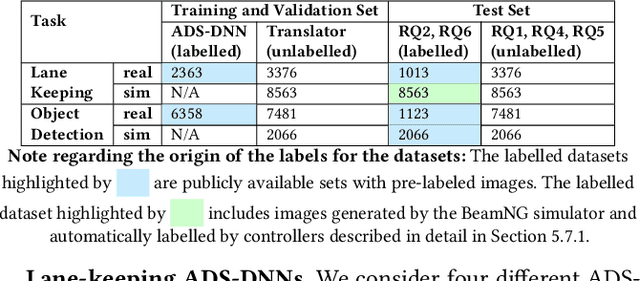Mohammad Hossein Amini
Bridging the Gap between Real-world and Synthetic Images for Testing Autonomous Driving Systems
Aug 25, 2024



Abstract:Deep Neural Networks (DNNs) for Autonomous Driving Systems (ADS) are typically trained on real-world images and tested using synthetic simulator images. This approach results in training and test datasets with dissimilar distributions, which can potentially lead to erroneously decreased test accuracy. To address this issue, the literature suggests applying domain-to-domain translators to test datasets to bring them closer to the training datasets. However, translating images used for testing may unpredictably affect the reliability, effectiveness and efficiency of the testing process. Hence, this paper investigates the following questions in the context of ADS: Could translators reduce the effectiveness of images used for ADS-DNN testing and their ability to reveal faults in ADS-DNNs? Can translators result in excessive time overhead during simulation-based testing? To address these questions, we consider three domain-to-domain translators: CycleGAN and neural style transfer, from the literature, and SAEVAE, our proposed translator. Our results for two critical ADS tasks -- lane keeping and object detection -- indicate that translators significantly narrow the gap in ADS test accuracy caused by distribution dissimilarities between training and test data, with SAEVAE outperforming the other two translators. We show that, based on the recent diversity, coverage, and fault-revealing ability metrics for testing deep-learning systems, translators do not compromise the diversity and the coverage of test data, nor do they lead to revealing fewer faults in ADS-DNNs. Further, among the translators considered, SAEVAE incurs a negligible overhead in simulation time and can be efficiently integrated into simulation-based testing. Finally, we show that translators increase the correlation between offline and simulation-based testing results, which can help reduce the cost of simulation-based testing.
Naïve Bayes and Random Forest for Crop Yield Prediction
Apr 23, 2024



Abstract:This study analyzes crop yield prediction in India from 1997 to 2020, focusing on various crops and key environmental factors. It aims to predict agricultural yields by utilizing advanced machine learning techniques like Linear Regression, Decision Tree, KNN, Na\"ive Bayes, K-Mean Clustering, and Random Forest. The models, particularly Na\"ive Bayes and Random Forest, demonstrate high effectiveness, as shown through data visualizations. The research concludes that integrating these analytical methods significantly enhances the accuracy and reliability of crop yield predictions, offering vital contributions to agricultural data science.
Evaluating the Impact of Flaky Simulators on Testing Autonomous Driving Systems
Nov 30, 2023Abstract:Simulators are widely used to test Autonomous Driving Systems (ADS), but their potential flakiness can lead to inconsistent test results. We investigate test flakiness in simulation-based testing of ADS by addressing two key questions: (1) How do flaky ADS simulations impact automated testing that relies on randomized algorithms? and (2) Can machine learning (ML) effectively identify flaky ADS tests while decreasing the required number of test reruns? Our empirical results, obtained from two widely-used open-source ADS simulators and five diverse ADS test setups, show that test flakiness in ADS is a common occurrence and can significantly impact the test results obtained by randomized algorithms. Further, our ML classifiers effectively identify flaky ADS tests using only a single test run, achieving F1-scores of $85$%, $82$% and $96$% for three different ADS test setups. Our classifiers significantly outperform our non-ML baseline, which requires executing tests at least twice, by $31$%, $21$%, and $13$% in F1-score performance, respectively. We conclude with a discussion on the scope, implications and limitations of our study. We provide our complete replication package in a Github repository.
 Add to Chrome
Add to Chrome Add to Firefox
Add to Firefox Add to Edge
Add to Edge